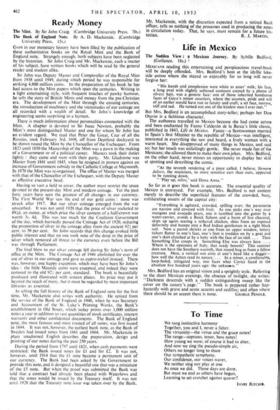Ready Money
GAPS in our monetary history have been filled by the publication of these authoritative books on the Royal Mint and the Bank of England note. Strangely enough, both subjects have been neglected by the historian. Sir John Craig and Mr. Mackenzie, each a master of his subject, have written books which will be read by the general reader and student alike.
Sir John was Deputy Master and Comptroller of the Royal Mint from 1938 until 1949, during which period he was responsible for striking 4,800 million coins. In the preparation of his book he has had access to the Mint papers which span the centuries. Writing in a light entertaining style, with frequent touches of pawky humour, he tells the story of British Mints and money from the pre-Christian era. The development of the Mint through the ensuing centuries, the introduction of machinery and the vicissitudes of our coinage are all recorded with a wealth of detail. Sir John's knowledge of engineering seems surprising to a layman.
There is much information about personalities connected with the Mint. A chapter is devoted to Sir Isaac Newton, probably the Mint's most distinguished Master and one for whom Sir John has an evident regard. We read that Peter the Great, Czar of all the Russias, took February 3td, 1698, off from Deptford dockyard to be shown round the Mint by the Chancellor of the Exchequer. From 1823 until 1850 the Mastership of the Mint was a pawn in the making of a Government or of a political career. Masters took their duties lightly : they came and went with their party. Mr. Gladstone was Master from 1841 until 1845, when he resigned in protest against an increase of Government subsidy to the Catholic College at Maynooth.
In 1870 the Mint was re-organised. The office of Master was merged with that of the Chancellor of the Exchequer, with the Deputy Master as effective executive head.
Having so vast a field to cover, the author must restrict the space devoted to the present-day Mint and modern coinage. Yet the past
forty years have seen the greatest of all changes in our currency.
The First World War saw the end of our gold coins : none was struck after 1917. But our silver coinage emerged from the war unscathed. It was not until 1920 that the price of silver rocketed to 891d. an ounce, at which price the silver content of a half-crown was worth 3s. 4d. This was too much for the Coalition Government of the day, which hurriedly passed the Coinage Act of 1920, reducing the proportion of silver in the coinage alloy from the ancient 921 per cent. to 50 per cent. Sir John records that this change evoked little public interest and that no one took note of the drop in the price of silver which removed all threat to the currency even before the Bill was through Parliament.
The final blow to our silver coinage fell during Sir John's term of office at the Mint. The Coinage Act of 1946 abolished for ever the use of silver in our coinage and gave us cupro-nickel instead. There was, however, one happy exception, which may have been Sir John's idea : the little Maundy coins were excepted, and indeed they were restored to the old 921 per cent. standard. The book is beautifully produced and illustrated with sixteen plates. Its price may put it beyond the reach of many, but it must be regarded by most important libraries as essential.
In telling the full history of the Bank of England note for the first time, Mr. Mackenzie also writes with authority. He retired from the service of the Bank of England in 1946, when he was Secretary and Accountant of the St. Luke's Printing Works, the Bank's establishment in Old Street, which today prints over 1,000 million notes a year in addition to vast quantities of stock certificates, interest warrants and other confidential documents. The Bank of England note, the most famous and most trusted of all notes, was first issued in 1694. It was not, however, the earliest bank note, as the Bank of Sweden had issued notes from 1661 until 1664. Mr. Mackenzie in plain unadorned English describes the preparation, design and printing of our notes during the past 250 years.
During the period from 1797 until 1821, when cash payments were restricted, the Bank issued notes for £1 and for £2. It was not,
however, until 1914 that the £1 note became a permanent unit of our currency. The Bank had been asked by the Government to provide this note, and it designed a beautiful one that was a miniature of the £5 note. But when the proof was submitted the Bank was told that a contract had already been placed with Waterlows and that the notes would be issued by the Treasury itself. It was not until 1928 that the Treasury note issue was taken over by the Bank. Mr. Mackenzie, with the discretion expected from a retired Bank officer, tells us nothing of the processes used in producing the notes in circulation today. That, he says, must remain for a future his-


































 Previous page
Previous page